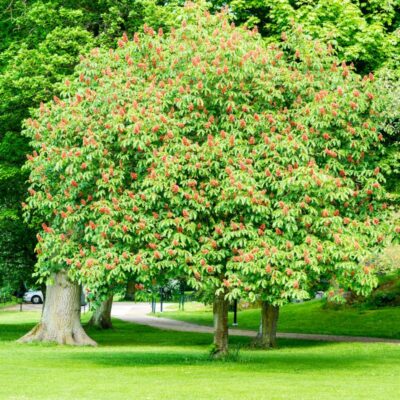Garden Plant: Red Buckeye
Product Description: Red Buckeye

Magnificent Spring Color Native Red Buckeye
- Dramatic Spring Blooms
- Vibrant Spring Color
- Perfect for Smaller Landscapes
- Very Distinctive Leaves
- Supports Butterflies
- Hardy, Easy Care Native Tree
- Grows in Sun or Partial Shade
- The Good Luck Tree
If you want to make an absolutely stupendous presentation in early spring, consider this wonderful native tree. One of the first plants to wake up in spring, Red Buckeye (Aesculus pavia) creates a splendid accent in the landscape.
This beautiful native shrub or small tree is also known as Firecracker Plant and Scarlet Buckeye. You may have seen the showy blooms and fallen in love.
And no wonder! The tubular flowers are vivid scarlet and can grow to 9 inches long. These lavish carmine blooms last several weeks and attract ruby-throated hummingbirds and butterflies. It is not uncommon for the Red Buckeye to begin blooming in the second or third year after planting.
Plant it in sun for a full, lusher profile. In shade, the plant opens up and becomes airier and a bit shrubbier.
It seems to thrive on neglect and will readily bloom. This amazing flowering tree grows in almost any soil type and is virtually disease and pest free.
This is a native deciduous tree and one of the first plants to leaf out in the spring. Even the highly textured leaves are lovely. They almost appear to be quilted!
Emerging burgundy-red in spring, they’ll offset the blooms beautifully. Turning a lustrous dark green, leaves are large and droop down in a charming way. They’ll provide plenty of interest throughout the growing season.
As the flowers finish, see if you can find a few of the unique, shiny brown seeds. You’ll have to hunt for them. Put one in your pocket for good luck!
How to Use Red Buckeye in the Landscape
Because it loses its leaves early in the fall, Red Buckeye may be best used as a really special accent tucked along a garden path. Create a “Garden Destination” in your landscape and use this as a springtime focal point. It is especially pretty when underplanted with early spring wildflowers.
It has a coarse-textured and open structure. In fall, allow it to hide a bit behind showier, fall-colored trees, like Flowering Dogwoods or Maples.
You can also use this tree as a pretty background tree. The trees bold canopy, beautiful bright-red blooms and light, flaky bark can make a great natural hedge when planted at 8 to 10 foot on center.
As with most Aesculus varieties, the Red Buckeye begins to go dormant early in the fall and it is not uncommon for the leaves to begin to turn color in the late summer or early fall. Place Burning Bushes, Red Twigged Dogwood and evergreen shrubs in front for a wonderful display that works all year.
Pro Plant Tips for Care
If possible, give it moist, well-drained soil, but it can adapt to a wide range of soil types. The tree does best when grown in full sun but can be grown in some shade in the warmer regions.
Plan to water in the early morning, so the drying power of the morning sun can dry the foliage. Be careful not to overwater this tree.
In the wild, Red Buckeye is often seen as a multi-trunk tree. But in the landscape, they are easily trained to a single trunk tree when young.
It is moderately drought-tolerant. In full sun locations, the tree benefits from a good mulch layer 3 to 4 inches deep. Extend this out to 3 feet beyond the canopy. This will help to keep the trees roots cool in the heat of the summer. In the hotter, drier areas of Zone 8, planting in a little afternoon shade will protect the tree from sunburn on the trunk.
Bold red flowers, beautiful palmately compound, large leaves and a lot of appeal for birds and butterflies make this special tree a standout in a nature lovers garden. Order this rare plant today!


